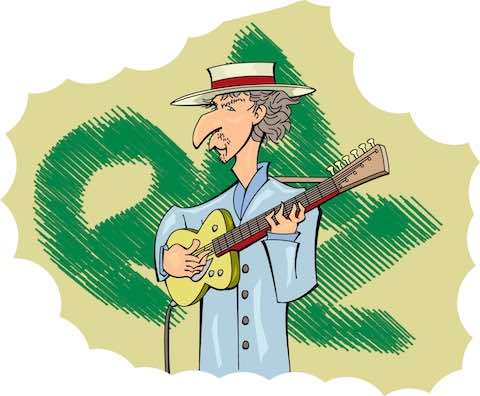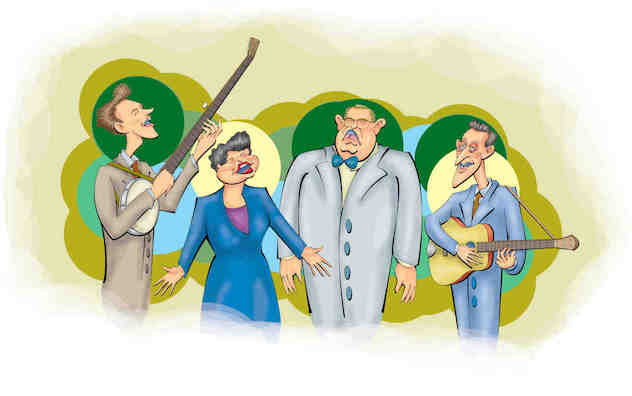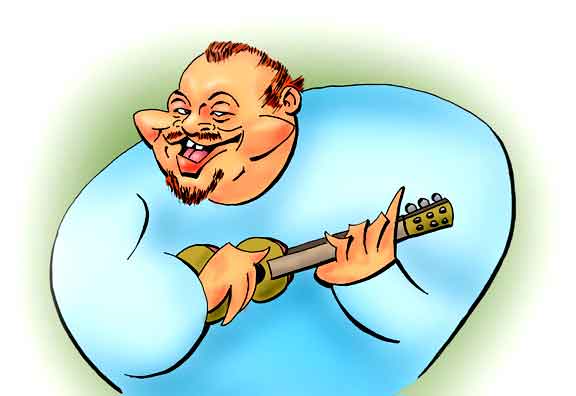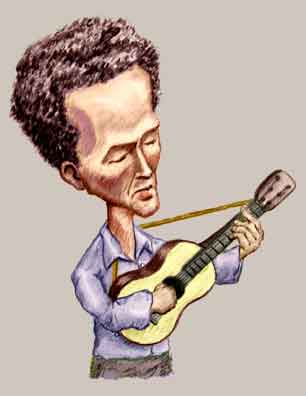Robert Allen Zimmerman
Nobel Laureate Littérateur

Sometimes study and commentary creates more questions than it answers. For instance, one topic which has brought study and commentary and questions is the vocal characteristics of the 2016 Nobel Laureate in Literature, Robert Allen Zimmerman.
There is much discussion on why Dr.1 Zimmerman - or Bob as his friends call him - sings like he does. Experts have weighed in - even an otolaryngologist - and they talk about the mechanism of the human vocal cords, the muscular actions that produce the sound, and changes that occur with age and use and even the effects of smoking (which Bob gave up). Not to mention decades of singing throughout a life of continual touring.
There's also the influence of other singers, of course. One author cited how Hank Williams, Jerry Lee Lewis and Elvis Presley influenced Bob's style. And of course there's Johnny Cash who wrote the liner notes to Bob's album "Nashville Skyline".
Bob has his defenders, of course, and a scholar from one of the World's Great Seats of Learning took the more severe critics to task. Yes, on Bob's earliest records there was an "unpolished" and "nasal" quality to his voice and he was not always hitting the pitch. This type of singing, the author pointed out, wasn't unique to Bob. It was in fact "similar to that of Woody Guthrie". And then on a popular informational website, the anonymous collective author(s) even suggested that in his first album Bob was "apparently" imitating Woody.
Ha? (To quote Shakespeare). Bob's singing was  similar to that of Woody Guthrie?
similar to that of Woody Guthrie?
He was  apparently imitating Woody Guthrie?
apparently imitating Woody Guthrie?
Mesdames et Messieurs, if there is one unshakeable, unquestionable, and  absolute fact in the history of the universe, it is that Bob's voice was not just
absolute fact in the history of the universe, it is that Bob's voice was not just  similar to or that he was
similar to or that he was  apparently imitating Woody Guthrie. The truth is that in the early 1960's when he burst onto the musical scene - and pardon us if we shout:
apparently imitating Woody Guthrie. The truth is that in the early 1960's when he burst onto the musical scene - and pardon us if we shout:
BOB DYLAN WAS CONSCIOUSLY, DELIBERATELY, AND
 INDUBITABLY
INDUBITABLY
IMITATING
THE SINGING OF
WOODY GUTHRIE.
So although Bob's singing changed in style, tone, and timbre as it does for all singers of longevity - after all just compare the early singing of Wayne Newton with his later songs - Bob's deliberate imitating of Woody served as the foundation of his later vocal styles. One scholar has found eight stages of Bob's development - and yes - he pointed out that Bob's first singing was modeled on that of Woody Guthrie.
But here's the kicker that even some of Bob's biggest fans may not know. There is a reason to believe that perhaps, just perhaps:
BOB WAS IMITATING
 SOMEONE ELSE
SOMEONE ELSE
 IMITATING
IMITATING
Woody's singing.
That someone was, as all folk music fans can now guess, Ramblin' Jack Elliott. Jack - whose real name was Elliot Adnopoz - said he was one of the first of the Brooklyn cowboys. Jack met Woody in 1952 in the Coney Island Hospital when Woody was recovering from an attack of appendicitis. Jack was only 19 and already a big fan.

Ramblin' Jack Elliott
Jack first heard Woody's singing from the records that were released during the 1940's. But now Jack had the opportunity to learn first hand from the master himself. Soon Jack was able to imitate Woody to the point that someone in another room would hear Jack talking and think it was Woody. Woody himself said "Jack sounds more like me than I do".
Still Jack had a bountiful amount of his own talent. By the end of 1961 he had eight albums to his credit, including one produced by the prestigious Columbia label. He had toured in both the US and in England.
Of course if you know of Bob Dylan you must know about The Folk Revival. There were, though, more than one. The first was in the late 1930's and early 40's which saw the emergence of groups like The Almanac Singers and The Weavers, singers like Peter Seeger (who was in The Almanacs and The Weavers), Burl Ives (who Woody Guthrie said sang like he was born in lace drawers), and yes, Woody. Then you had the late 50's and early 60's which was the big Folk Revival and the one most people talk about. That revival reached its surge with the release of "Tom Dooley" by the Kingston Trio. More records, singers, folk-groups, and even television shows followed. But by the late 1960's interest was fading, but there was another and relatively brief revival in the early 70's when the Nitty Gritty Dirt Band released their album Will the Circle Be Unbroken.
The First Revival

The Weavers ...

... Pete ...

...... Burl ...

......... and Woody.
Bob emerged during second revival around Dinkytown, the campus corner of the University of Minnesota. As he learned to play the guitar, he heard some of Woody's recordings and became a true fan. Bob managed to borrow a copy of Woody's book, Bound for Glory, from one of his professors. This was Woody's story of his growing up in Oklahoma and Texas. When Bob finished the book he was determined to meet Woody who he learned was living in New York.
Bob hitchhiked to New York in 1959. Woody, though, was no longer residing on Coney Island. Instead he was confined to the Greystone State Hospital in Morris Plains, New Jersey, with the Huntington's disease which he had inherited from his mother. But Woody was a weekly visitor at the home of Bob and Sidsel Gleason where Woody's friends and family would gather on Sundays.
The details of how Bob actually met Woody vary slightly depending on the source. One account was that Bob was still in Minnesota when he learned Woody was at Greystone and had phoned the hospital. He was told that Mr. Guthrie couldn't come to the phone. But since patients were allowed visitors, Bob went to the hospital and met him there.
Another story is that once he got to New York he learned that Woody's family lived on Coney Island and so went knocking on their door. Woody's son Arlo and Bob quickly reached a good rapport and Arlo told Bob of the weekend get-togethers at the Gleasons. But Jack definitely said that he met Bob at the hospital after his returned from Europe. Bob told Jack about the Gleasons and Jack began to show up on Sunday as well.
When Bob met Woody, Woody was no longer able to sing or play the guitar. So Bob honed his skills singing like Woody by listening to Jack singing like Woody. And if you compare Jack and Bob's vocals, you actually hear greater similarities compared to Woody whose voice had a deeper and huskier timbre than either Jack or Bob. The differences are particularly noticeable on Woody's later recordings.
Ironically, Jack didn't think Bob was imitating him at first although Bob had received criticism for doing just that. In fact, when Bob appeared at Gerdes Folk City in his first real public performance - Gerdes was THE platform if you were a folk singer - Bob was billed as:
 The SON of
The SON of
Jack Elliott 2
Footnote
This billing must have been posted only at the club itself as none of the extant flyers or posters heralding Bob's appearance mention Jack at all. Jack himself said the idea for the billing was certainly not his but likely from someone on Gerdes' staff.
The manner and style that Bob would have sung if he had not met Jack is of course a matter which can never be answered. But if anyone doubts that Bob has a debt to Jack we only need to turn to what Jack himself said.
"He owes me $12," Jack commented, "but that's okay."
References and Further Reading
"Bob Dylan Receives Honorary Princeton Degree", Rolling Stone, July 9, 1970.
Ramblin' Man: The Life and Times of Woody Guthrie, Ed Cray. Norton, 2004.
"Bob Dylan's Voice, Explained", Jared Hemming, City Pages, January 29, 2016.
"Can We Talk About Dylan’s Voice?", Ken Hymes, Culture Sonar, March 31, 2016.
"How Bob Dylan Found His New Country Voice on 'Nashville Skyline', Simon Vozick-Levinson, Rolling Stone, April 8, 2016.
"Unpopular Opinion: In Defense of Bob Dylan's Singing", Alasdair MacKenzie, Harvard Chrimson, September 23, 2018.
"Dylan’s Voice", Edward O'Connor, The Junction, Part 1, September 23, 2018, Part 2, March 29, 2019.
The Life, Music and Thought of Woody Guthrie: A Critical Appraisal, John Partingtonm Ashgate, 2011, Routledge, 2016.
"8 Voices of Bob Dylan", Rob Jones, The Delete Bin, May 24, 2010.
"Ramblin' Man", John La Briola , Westworld, June 2, 2005.
Woody Guthrie: A Life, Joe Klein, Knopf, 1980.
Ramblin' Man: The Life and Times of Woody Guthrie, Ed Cray. Norton, 2004.
"Ramblin’ Jack Elliott On the Debts Between Him and Bob Dylan", Brad Wheeler, The Globe and Mail, October 26, 2016.
"Ruptured appendix hospitalized Woody Guthrie", Ed Sullivan, "Litte Old New York", The Daily Record, Page 4, February 19, 1951.